New website will help you debunk the misinformation you see posted on social media
Your conspiracy-loving uncle is going to hate this.

RumorGuard by The News Literacy Project.
The 2016 election was a watershed moment when misinformation online became a serious problem and had enormous consequences. Even though social media sites have tried to slow the spread of misleading information, it doesn’t show any signs of letting up.
A NewsGuard report from 2020 found that engagement with unreliable sites between 2019 and 2020 doubled over that time period. But we don’t need studies to show that misinformation is a huge problem. The fact that COVID-19 misinformation was such a hindrance to stopping the virus and one-third of American voters believe that the 2020 election was stolen is proof enough.
What’s worse is that according to Pew Research, only 26% of American adults are able to distinguish between fact and opinion.
To help teach Americans how to discern real news from fake news, The News Literacy Project has created a new website called RumorGuard that debunks questionable news stories and teaches people how to become more news literate.
\u201cLove this. We need to make it easy for people to know the difference between what is real and what is misinformation. It\u2019s especially helpful that @NewsLitProject shows the process of how they debunk these rumors.\u201d— Melissa Luck \u2618 (@Melissa Luck \u2618) 1664976259
“Misinformation is a real threat to our democracy, our health and our environment. But too many people are not sure how to verify the news they come across and are convinced there is no useful action they can take to protect themselves and others from being fooled,” Charles Salter, NLP’s president and CEO, said in a statement. “We can confront these challenges by making sure more people have news literacy skills and the ability to collectively push back against the spread of false, misleading and harmful content.”
The site regularly posts debunked news stories to push back against the lies that spread online. The great thing is that the stories explain why the information shouldn’t be trusted.
Each post explains how to use five major factors of credibility to judge whether a claim is legitimate and walks the reader through the debunking process. The five criteria are a great thing to consider any time someone is reading a news article.
Source: Has the information been posted by a credible source?
Evidence: Is there any evidence that proves the claim is true?
Context: Is the provided context accurate?
Reasoning: Is the claim based on sound reasoning?
Authenticity: Is the information authentic, or has it been edited, changed, or completely made up?
The site also provides lessons to teach people how to identify misinformation so they don’t fall for it in the future. Studies show that the best way to combat misinformation is by inoculating people against it by teaching them how to spot the deceptive tactics used by illegitimate news sites.
\u201cFeel empowered \ud83d\udcaa\ud83c\udffe\nStop misinformation in its tracks \u274c\nJoin the #RumorGuard today! \n\n\ud83d\udd17 https://t.co/xLs55ws8HJ\u201d— The News Literacy Project (@The News Literacy Project) 1664974988
A recent study highlighted by Upworthy from researchers from universities of Cambridge and Bristol found that “pre-bunking” was one of the most effective ways to stop the spread of misinformation.
“Across seven high-powered preregistered studies including a field experiment on YouTube, with a total of nearly 30,000 participants, we find that watching short inoculation videos improves people’s ability to identify manipulation techniques commonly used in online misinformation, both in a laboratory setting and in a real-world environment where exposure to misinformation is common,” the recently published findings note.
Over the past six years, there have been numerous attempts by social media platforms and fact-checking organizations to try to stop the spread of false information online as it slowly erodes our democracy. RumorGuard seems to be following the lessons we’ve learned over the past few years by providing fact-checks to big news stories in real time and by helping to inoculate people against fake news in the future.
Let’s hope we can stop the spread of misinformation while we still have a democracy to protect.
- COVID vaccine misinformation is out of hand. Let's examine some of ... ›
- John Oliver Goes Off On An Epic, Fact-Checked, Mic-Dropping Rant ... ›
- Historian offers a fact check on myths about infant feeding pre ... ›
- She's an expert at spotting fake news. This is what she wants you to know. - Upworthy ›
- Simple trick to changing misinformed people's minds - Upworthy ›





 Rihanna Nails GIF
Rihanna Nails GIF A photo of Helen and Bill in their uniformsImages provided by Drew Coyle
A photo of Helen and Bill in their uniformsImages provided by Drew Coyle The map provided by Helen to Bill@crewdoyle/
The map provided by Helen to Bill@crewdoyle/ Helen and Bill, happy and and content, and oh so in love. Image from Drew Coyle
Helen and Bill, happy and and content, and oh so in love. Image from Drew Coyle Good luck trying to catch a gazelle.
Good luck trying to catch a gazelle. Chickens will eat just about anything.
Chickens will eat just about anything. There's actually a big difference between horses and zebras besides just the stripes.
There's actually a big difference between horses and zebras besides just the stripes. A photo of a portable carbon monoxide detector from Amazon
A photo of a portable carbon monoxide detector from Amazon


